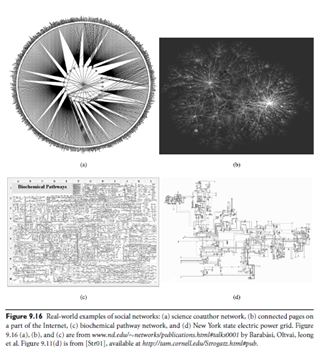SKEDSOFT
Introduction: The notion of social networks, where relationships between entities are represented as links in a graph, has attracted increasing attention in the past decades. Thus social network analysis, from a data mining perspective, is also called link analysis or link mining. From the point of view of data mining, a social network is a heterogeneous and multi-relational data set represented by a graph. The graph is typically very large, with nodes corresponding to objects and edges corresponding to links representing relationships or interactions between objects. Both nodes and links have attributes. Objects may have class labels. Links can be one-directional and are not required to be binary.
Social networks need not be social in context. There are many real-world instances of technological, business, economic, and biologic social networks. Examples include electrical power grids, telephone call graphs, the spread of computer viruses, the World Wide Web, and coauthor ship and citation networks of scientists. Customer networks and collaborative filtering problems (where product recommendations are made based on the preferences of other customers) are other examples. In biology, examples range from epidemiological networks, cellular and metabolic networks, and food webs, to the neural network of the nematode worm Caenorhabditis elegans (the only creature whose neural network has been completely mapped). The exchange of e-mail messages within corporations, newsgroups, chat rooms, friendships, sex webs (linking sexual partners), and the quintessential “old-boy” network (i.e., the overlapping boards of directors of the largest companies in the United States) are examples from sociology.
 Small world (social) networks have received considerable attention as of late. They reflect the concept of “small worlds,” which originally focused on networks among individuals. The phrase captures the initial surprise between two strangers (“What a small world!”) when they realize that they are indirectly linked to one another through mutual acquaintances. In 1967, Harvard sociologist, Stanley Milgram, and his colleagues conducted experiments in which people in Kansas and Nebraska were asked to direct letters to strangers in Boston by forwarding them to friends who they thought might know the strangers in Boston. Half of the letters were successfully delivered through no more than five intermediaries. Additional studies by Milgram and others, conducted between other cities, have shown that there appears to be a universal “six degrees of separation” between any two individuals in the world. Examples of small world networks are shown in Figure 9.16. Small world networks have been characterized as having a high degree of local clustering for a small fraction of the nodes (i.e., these nodes are interconnected with one another), which at the same time are no more than a few degrees of separation from the remaining nodes. It is believed that many social, physical, human-designed, and biological networks exhibit such small world characteristics. These characteristics are further described and modeled in Section 9.2.2.
Small world (social) networks have received considerable attention as of late. They reflect the concept of “small worlds,” which originally focused on networks among individuals. The phrase captures the initial surprise between two strangers (“What a small world!”) when they realize that they are indirectly linked to one another through mutual acquaintances. In 1967, Harvard sociologist, Stanley Milgram, and his colleagues conducted experiments in which people in Kansas and Nebraska were asked to direct letters to strangers in Boston by forwarding them to friends who they thought might know the strangers in Boston. Half of the letters were successfully delivered through no more than five intermediaries. Additional studies by Milgram and others, conducted between other cities, have shown that there appears to be a universal “six degrees of separation” between any two individuals in the world. Examples of small world networks are shown in Figure 9.16. Small world networks have been characterized as having a high degree of local clustering for a small fraction of the nodes (i.e., these nodes are interconnected with one another), which at the same time are no more than a few degrees of separation from the remaining nodes. It is believed that many social, physical, human-designed, and biological networks exhibit such small world characteristics. These characteristics are further described and modeled in Section 9.2.2.
The reason is that structure always affects function. For example, the topology of social networks affects the spread of infectious disease through a structured population. The topology of a power grid affects the stability and robustness of its power transmission. For instance, a power failure in Cleveland, Ohio, on August 14, 2003, triggered, through an interconnecting grid system, the shutting down of nuclear power plants in New York state and Ohio, and led to widespread power blackouts in many parts of the Northeastern United States and Southeastern Canada, which affected approximately 50 million people. The interest in networks is part of broader research in the accurate and complete description of complex systems. Previously, the networks available for experimental study were small and few, with very little information available regarding individual nodes. Thanks to the Internet, huge amounts of data on very large social networks are now available.
These typically contain from tens of thousands to millions of nodes. Often, a great deal of information is available at the level of individual nodes. The availability of powerful computers has made it possible to probe the structure of networks. Searching social networks can help us better understand how we can reach other people. In addition, research on small worlds, with their relatively small separation between nodes, can help us design networks that facilitate the efficient transmission of information or other resources without having to overload the network with too many redundant connections. For example, it may help us design smarter search agents on the Web, which can find relevant websites in response to a query, all within the smallest number of degrees of separation from the initial website (which is, typically, a search engine).